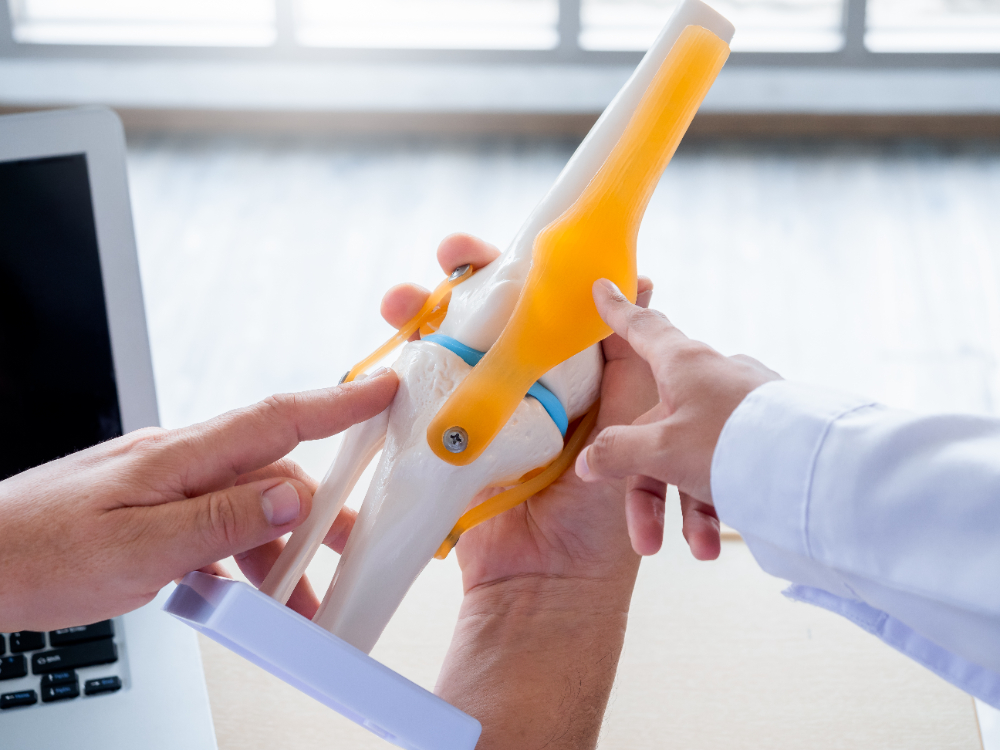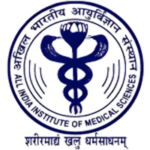
Best Arthroscopy Surgery In India by Dr. Dhruv Sharma
WHAT ARE KNEE LIGAMENTS?
Lets understand this in a simple way. Knee joint is formed of the thigh bone (femur) above and the shin bone (tibia) below. These are like two wooden sticks that can not maintain balance own its own. Therefore there are ligaments in the knee just like rubber bands that help these two bones stand on each other while allowing movements at the knee. They act to stabalise the knee during various activities like walking, running, jumping and changing directions. These rubber bands or ligaments are Anterior cruciate ligament (ACL), Posterior cruciate ligament (PCL), Medial Collateral ligament (MCL) and Lateral Collateral ligament (LCL).
ACL: ACL or the anterior cruciate ligament binds the two bones, tibia and femur in such a way that it prevents excessive forward movement of tibia with respect to femur.
PCL: PCL or the posterior cruciate ligament prevents excess backward movement of tibia on the femur.
MCL: MCL or the medial collateral ligament prevents excessive outward movement of tibia with respect to femur.
LCL: LCL or the lateral collateral ligament prevents excessive inward movement of the tibia with respect to femur.
WHY IS ACL OF SPECIAL IMPORTANCE?
ACL is of special importance for three reasons:
- Complete tear of ACL (Grade 3) can not heal without surgery while other ligament tears can be managed without surgery.
- ACL is the most common ligament to get injured.
- Complete ACL tear (Grade 3) always produce symptoms while other ligament tear may go unnoticed.
WHEN CAUSES AN ACL INJURY?
ACL injury occurs when the ligament is stretched, partially torn or completely torn. This often happens in a high-impact sports or activities that involve sudden stops, twists or change in direction. It can also happen in a road accident like fall from a bike where there happens a sudden twist or stop or jerky movement to the knee.
Causes of ACL injury:
- Sudden pivoting movement
- Landing awkwardly from a jump
- Direct impact on the knee
- Deceleration during running
WHAT SYMPTOMS ARE OBSERVED IN ACL INJURY?
- A LOUD POP: Patients typically feel a loud pop at the time of injury as if something inside the knee has abruptly broken.
- PAIN: Intense pain is felt in the knee and patient finds it difficult to continue walking. It is important to note that this pain subsides with conservative treatment significantly within weeks. Pain is not the disabling symptom that the patient faces in the long run unless there is associated meniscal injury.
- SWELLING: The knee swells within hours of injury. It is again important to note that swelling subsides with conservative treatment within weeks. Swelling is not the disabling symptom that the patient faces in the long run.
- INSTABILITY OF THE KNEE: This is the main symptom that troubles the patient in long run because it doesn’t go away with conservative methods. Patient feels that he has no control on the knee. He feels the knee is unstable. He finds it difficulty to walk fast or run because these activities require a stable knee. This is the main symptom that prevents the sportsperson from returning to games and this is the main aim of surgical intervention.
HOW DOES YOUR KNEE SPECIALIST CONFIRM AN ACL INJUURY?
Your knee specialist will perform a series of clinical and radiological tests to confirm ACL tear.
Clinical examination: When you visit your knee specialist, he may demonstrate to you that your injured knee is unstable compared to the normal knee by special clinical tests namely Lachman test, Anterior drawer test and Pivot shift test.
Lachman test: The knee is flexed to 15 degrees and foot os stabilised on the couch. Tibia is fulled forward and it demonstrates more exclusion compared to the normal side. A normal stabilises the knee and prevents excess forward movement of tibia on femur. A torn ACL is incompetent to do this and therefore the the knee becomes unstable.
Anterior drawer test: The knee is flexed to 90 degrees and foot is stabilised on the couch. Tibia is pulled forward and it demonstrates more excursion compared to the uninjured side.
A normal stabilises the knee and prevents excess forward movement of tibia on femur. A torn ACL is incompetent to do this and therefore the the knee becomes unstable.
Pivot shift test of Macintosh: The doctor holds the patient’s leg and flexes it to 30 degrees. One land holds the upper tibia just below the knee and other hand holds the ankle. An inward force (valgus) is applied to the knee with one hand and the tibia is internally rotated by the other. The knee is gradually extended. The tibia shifts forward when the knee is flexed while it reduces with a ‘clunk’ when it is extended. This demonstrates a rotational instability and suggests a torn ACL. However this test may not be demonstrable in an alert patient and is more appreciable under anaesthesia.
MRI: MRI is the standard investigation where your doctor may show you that your ACL is torn. However we must understand that MRI is an indirect imaging technique and in few cases ACL tear may be missed like in incomplete but significant tears. In such a situation, a diagnostic arthroscopy may be required.
Diagnostic arthroscopy: In very specific situations where you clinically have symptoms of ACL tear but your MRI does not show it, your doctor may plan diagnostic arthroscopy. Here a specialised instrument called arthroscope is inserted into the knee and with help of camera the doctor directly sees if ACL is torn or intact.
WHAT ARE THE TYPES OF ACL TEAR?
Types of ACL tear
Grade 1 : Your ACL is just stretched out but not torn into two parts. This is the least severe type of tear and does not require surgery. Just consult your orthopedician and he will help you recover.
Grade 2 : Your ACL is partially torn. Your knee may be totally stable or slightly unstable. Depending on the severity of your problem and your functional demands, you may do without surgery or rarely may require surgery. This tear is however rare.
Grade 3 : ACL is completely torn and knee is unstable. This definitely requires surgery. Choose your ACL surgeon and the technique he performs wisely.
CAN ACL TEARS HEAL WITHOUT SURGERY?
As mentioned above, Grade 1 ACL tears heal well without surgery because they are not tears in true sense, they are just happens stretching of ACL.
Grade 2 tears if produce symptoms of instability of knee may require surgery.
Grade 3 tears almost always produce symptoms and require surgery.
WHAT ARE NON-SURGICAL OPTIONS IN ACL TEARS?
This fact can’t be over-emphasized that only grade-1 tears can heal with conservative measures. These conservative measures include:
Hot and cold packs: For the initial 5-7 days when the swelling is acute, cold packs are advisable to alleviate the swelling. Once the swelling subsides, hot packs are started. Hot packs help overcome joint and muscle stiffness and help on restoring knee movements.
Rest: Rest is required for initial 1-2 weeks to help reduce swelling because repeated knee movements in the initial phase would cause repeated micro-trauma and decelerate the healing process.
Splintage: If the swelling is too much or pain is intense, immobilisation of the knee in a knee immobiliser or a plaster is advisable for 2-3 weeks. It puts the knee to rest and alleviate pin and swelling.
Painkillers: Painkillers in form of non-steroidal anti-inflammatory drugs serve dual purpose:
- Decrease pain
- Decrease swelling
They may be prescibed by your knee specialists for 3-5 days depending your situation.
Physiotherapy: For initial period, physical therapy may not be useful but once the swelling and pain gets better, knee movements are started to achieve full range of motion of knee and overcome knee stiffness. Patient may require a supervised physiotherapy regime if stiffness is too much.
WHAT ARE SURGICAL OPTIONS IN ACL SURGERY?
There are three surgical techniques we practice for ACL surgeries:
- ACL REPAIR
What is ACL repair surgery?
The torn ACL is sutured end-to end in ACL repair. No tendon graft is used for its augmentation or reconstruction.
When should ACL repair surgery be done?
ACL repair surgery should be wisely chosen and is not recommended for all due to its high failure rates. Only if ACL tear is acute of less than three weeks duration, ACL repair is advisable. There should be an isolated ACL tear, all other knee structures should be intact. These other structures mean posterior cruciate ligament, medial collateral ligament, lateral collateral ligament, medial and lateral menisci.
What is success rate of ACL repair?
ACL repair is successful in only 80-90% cases. Cases selection is very important.
How do we do ACL repair?
In all cases we augment ACL repairs with fibre-tape internal brace. It acts as an internal splint while the ACL is healing. This is because there are high chances of repair failure if there occurs even a minor twist or bend of knee while the repair is healing.
-
ACL AUGMENTATION
What is ACL augmentation?
ACL has two bundles, anteromedial and posterolateral. If only one of the bundles is torn and the other one is intact, augmentation of the intact bundle is done with hamstring or peroneus longus graft. We prefer to further augment it with a Fibretape Internal brace. It acs as an internal splint and aids in early rehabilitation and return to sports.
What is success rate of ACL augmentation?
In our hands we provide a success rate of 99-100%.
How do we do ACL augmentation?
We generally prefer to strengthen ACL augementation with fibre tape internal brace because most our patients are atheletes and want to return to sports early. With fibre tape internal brace we mobilise the patient early and rehabilitation time reduces significantly. Return to sports is quick and more effective. However if patient is not involved in sports, he may opt for a surgery without fibre tape internal brace.
-
ACL RECONSTRUCTION
What is ACL reconstruction?
When there is complete ACL tear, the entire ACL needs to be reconstructed. Here we use hamstring or peroneus longs graft and implant it in the location of original ACL and fix it with implants like loops, buttons and screws. This is called ACL reconstruction.
What is success rate of ACL reconstruction?
In our hands, we provide success rate of 99-100%.
How do we do ACL reconstruction?
We generally prefer to augment ACL reconstruction with fibre tape internal brace because most our patients are atheletes and want to return to sports early. With fibre tape internal brace we mobilise the patient early and rehabilitation time reduces significantly. Return to sports is quick and more effective. However if patient is not involved in sports, he may opt for ACL reconstruction without fibre tape internal brace.


